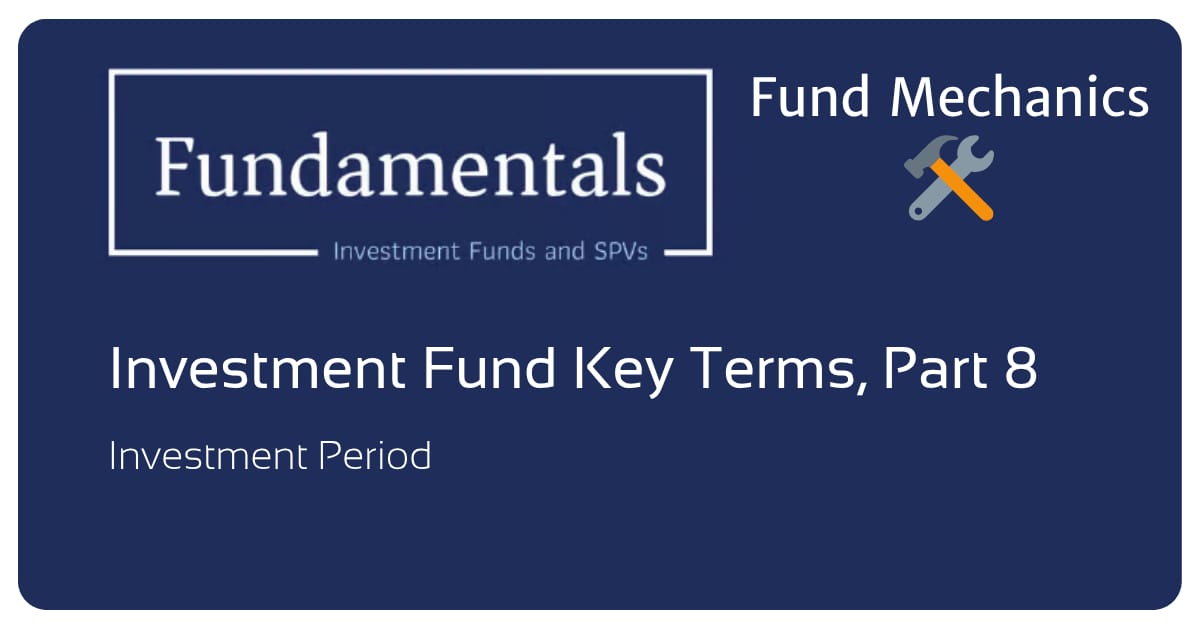- Fundamentals
- Posts
- 🛠️ Investment Fund Key Terms, Part 8
🛠️ Investment Fund Key Terms, Part 8
Investment Period

🎉 Happy Friday, funds family!
Today, we have Part 8 in our many-part series walking through each term in an investment fund term sheet in detail.
Last week, we discussed 🛠️ Fundraising Period. Today, we'll learn about the Investment Period.
But first..
/ SELF PROMOTION

If you’re a sponsor (GP) raising an investment fund or syndication in private equity, private credit, real estate, or venture capital, we may be a good fit for you. We also represent limited partners (LPs) investing in funds and syndications.
Thanks for reading. Now, let’s jump into the article 😃
A fund’s “investment period” is the phase when the GP is authorized to deploy capital into new investments. 📈
A standard investment period might look like this:
“The period during which the Fund may make new Portfolio Investments (the “Investment Period”) shall commence on the Initial Closing Date and shall continue for four (4) years thereafter, subject to extension by up to one (1) year at the discretion of the General Partner or such longer period as approved by the Limited Partner Advisory Committee (the “LPAC”). Following the expiration of the Investment Period, the Fund may make follow-on investments in existing Portfolio Companies but shall not make new investments without LPAC consent.”
➡️ How long is the investment period?
Most closed-end funds set an investment period of 3-5 years from the fund’s initial closing date. The specific timeline often depends on the strategy and asset class.
As with the fundraising period and the fund’s term, GPs sometimes retain the right to extend the investment period by 6–12 months.
➡️ What happens when the investment period ends?
When the investment period ends, the fund stops making new investments.
However, the GP can generally:
Make follow-on investments in existing portfolio companies (for example, to protect or enhance prior investments).
Reserve capital for expenses, fees, or reserves related to existing assets.
Exercise options, warrants, and similar rights to acquire investments.
But the GP cannot initiate new investments — unless approved by the LPAC or a majority of LPs.
In short, the fund transitions from its “growth” phase into its “management and exit” phase.
➡️ Why does the investment period matter?
The investment period affects:
Deployment expectations: LPs use it to forecast capital call schedules and portfolio diversification.
Management fees: In most funds, the management fees decrease at the end of the investment period (either by changing the management fee percentage or the base on which the management fee is calculated).
Governance: Certain restrictions (such as time/attention requirements and successor fund restrictions) are eliminated at the end of the investment period.
It’s a key investor protection that ensures discipline and transparency in how long the GP has to put capital to work.
➡️ What about open-ended funds?
In open-ended funds, there’s usually no defined investment period. The GP can continuously invest capital as new subscriptions come in and redemptions go out.
🗓️ Next up in Part 9, we’ll discuss capital recycling.
Thanks for reading, everyone.
Have a great weekend! 🙌
/ JURY TRIAL
How did you like today's post? |
Have you enjoyed this newsletter? Don’t forget 🔗 to share it with your GP, Co-GP, LPs, or anyone else you think might find it valuable!
You can also propose a topic that you would like us to cover! Just reply to this email or submit your suggestions 🔗 here.
⚠️ Note: This newsletter is for informational purposes only and nothing should be considered legal advice. For that, hire a lawyer! I am a lawyer, but not your lawyer (unless I actually am your lawyer because you’ve signed an engagement letter and we’re working together). This newsletter may be considered attorney advertising.
Reply